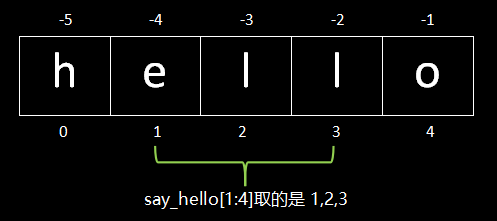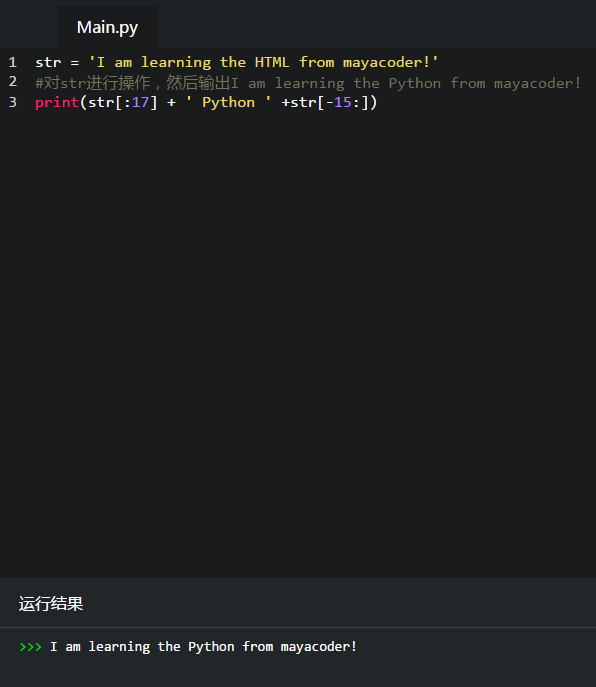 Backend Development
Backend Development
 Python Tutorial
Python Tutorial
 Python novices learn basic data types - slicing and intercepting strings
Python novices learn basic data types - slicing and intercepting strings
Python novices learn basic data types - slicing and intercepting strings
Slice interception is some common string operations in Python. We will introduce it in detail in this article. The function of slice interception is to obtain subcharacters or substrings.
In fact, what we have to do is to use indexes and separate the two indexes with a colon, in the form: variable [head subscript: tail subscript], the number before the colon represents the starting position, and the number after the colon represents the end. Location. This is a left-closed and right-open interval, which means that this string contains the head subscript, but does not contain the tail subscript.
Python data has two indexing methods: the leftmost element starts with 0 and increases in order; the rightmost element index is -1 and decreases in order to the left.
Python’s indexing is very flexible, and you can choose the corresponding indexing method according to the specific situation.
String index
Use the index to get a certain character in the string. Just use the subscript [x] directly. Don’t forget that the index starts from 0!
For example, for a string language="Python", 'P' can be obtained by using language[1] and lanuage[-5].
Split, slice and intercept
Python’s slicing operation often uses split slices, that is, using colons (:) in [] to split strings.
Take say_hell= 'hello' as an example:

As mentioned above, the syntax for using slices is: string variable name [x:y], which represents a period of characters with subscripts from x to y String (excluding y). When x is not written as, like [:y], it means starting from the beginning, equivalent to [0:y]. When y is not written, it means all the way to the end. When neither x nor y is written, it represents the entire string.
Step size slice interception
Step size interception, unlike the previous slice interception operation, it takes the value according to a certain number of "steps".
The syntax is:
Use two colons, such as
Python code
[X::y]
, x means starting from x, y means taking y steps to take a value, and continue until the end. For example, taking the previous str [1::3], that is, starting from the second character, taking a value every 3 bits, the result is eo.
Try!
We have learned to operate and slice strings, so now let’s consolidate the review and do an exercise:
Strings can be concatenated using (+) or (*) Repeat.
Strings can be accessed using index (str[index]).
Strings support slicing operations. Use colon : in [] to split the string and intercept a certain segment of the string.
Strings can be intercepted every few times using step size [x::y] slicing.
Use the knowledge you learned earlier, intercept "I am learning the HTML from mayacoder!" and output "I am learning the Python from mayacoder!". Don't forget that spaces are also characters.
Think about it~~
The answer to the code is this (not the only one):


Hot AI Tools

Undresser.AI Undress
AI-powered app for creating realistic nude photos

AI Clothes Remover
Online AI tool for removing clothes from photos.

Undress AI Tool
Undress images for free

Clothoff.io
AI clothes remover

AI Hentai Generator
Generate AI Hentai for free.

Hot Article

Hot Tools

Notepad++7.3.1
Easy-to-use and free code editor

SublimeText3 Chinese version
Chinese version, very easy to use

Zend Studio 13.0.1
Powerful PHP integrated development environment

Dreamweaver CS6
Visual web development tools

SublimeText3 Mac version
God-level code editing software (SublimeText3)

Hot Topics
 1376
1376
 52
52
 How to use mysql after installation
Apr 08, 2025 am 11:48 AM
How to use mysql after installation
Apr 08, 2025 am 11:48 AM
The article introduces the operation of MySQL database. First, you need to install a MySQL client, such as MySQLWorkbench or command line client. 1. Use the mysql-uroot-p command to connect to the server and log in with the root account password; 2. Use CREATEDATABASE to create a database, and USE select a database; 3. Use CREATETABLE to create a table, define fields and data types; 4. Use INSERTINTO to insert data, query data, update data by UPDATE, and delete data by DELETE. Only by mastering these steps, learning to deal with common problems and optimizing database performance can you use MySQL efficiently.
 How does PS feathering control the softness of the transition?
Apr 06, 2025 pm 07:33 PM
How does PS feathering control the softness of the transition?
Apr 06, 2025 pm 07:33 PM
The key to feather control is to understand its gradual nature. PS itself does not provide the option to directly control the gradient curve, but you can flexibly adjust the radius and gradient softness by multiple feathering, matching masks, and fine selections to achieve a natural transition effect.
 Do mysql need to pay
Apr 08, 2025 pm 05:36 PM
Do mysql need to pay
Apr 08, 2025 pm 05:36 PM
MySQL has a free community version and a paid enterprise version. The community version can be used and modified for free, but the support is limited and is suitable for applications with low stability requirements and strong technical capabilities. The Enterprise Edition provides comprehensive commercial support for applications that require a stable, reliable, high-performance database and willing to pay for support. Factors considered when choosing a version include application criticality, budgeting, and technical skills. There is no perfect option, only the most suitable option, and you need to choose carefully according to the specific situation.
 How to set up PS feathering?
Apr 06, 2025 pm 07:36 PM
How to set up PS feathering?
Apr 06, 2025 pm 07:36 PM
PS feathering is an image edge blur effect, which is achieved by weighted average of pixels in the edge area. Setting the feather radius can control the degree of blur, and the larger the value, the more blurred it is. Flexible adjustment of the radius can optimize the effect according to images and needs. For example, using a smaller radius to maintain details when processing character photos, and using a larger radius to create a hazy feeling when processing art works. However, it should be noted that too large the radius can easily lose edge details, and too small the effect will not be obvious. The feathering effect is affected by the image resolution and needs to be adjusted according to image understanding and effect grasp.
 How to optimize database performance after mysql installation
Apr 08, 2025 am 11:36 AM
How to optimize database performance after mysql installation
Apr 08, 2025 am 11:36 AM
MySQL performance optimization needs to start from three aspects: installation configuration, indexing and query optimization, monitoring and tuning. 1. After installation, you need to adjust the my.cnf file according to the server configuration, such as the innodb_buffer_pool_size parameter, and close query_cache_size; 2. Create a suitable index to avoid excessive indexes, and optimize query statements, such as using the EXPLAIN command to analyze the execution plan; 3. Use MySQL's own monitoring tool (SHOWPROCESSLIST, SHOWSTATUS) to monitor the database health, and regularly back up and organize the database. Only by continuously optimizing these steps can the performance of MySQL database be improved.
 What impact does PS feathering have on image quality?
Apr 06, 2025 pm 07:21 PM
What impact does PS feathering have on image quality?
Apr 06, 2025 pm 07:21 PM
PS feathering can lead to loss of image details, reduced color saturation and increased noise. To reduce the impact, it is recommended to use a smaller feather radius, copy the layer and then feather, and carefully compare the image quality before and after feathering. In addition, feathering is not suitable for all cases, and sometimes tools such as masks are more suitable for handling image edges.
 How to optimize MySQL performance for high-load applications?
Apr 08, 2025 pm 06:03 PM
How to optimize MySQL performance for high-load applications?
Apr 08, 2025 pm 06:03 PM
MySQL database performance optimization guide In resource-intensive applications, MySQL database plays a crucial role and is responsible for managing massive transactions. However, as the scale of application expands, database performance bottlenecks often become a constraint. This article will explore a series of effective MySQL performance optimization strategies to ensure that your application remains efficient and responsive under high loads. We will combine actual cases to explain in-depth key technologies such as indexing, query optimization, database design and caching. 1. Database architecture design and optimized database architecture is the cornerstone of MySQL performance optimization. Here are some core principles: Selecting the right data type and selecting the smallest data type that meets the needs can not only save storage space, but also improve data processing speed.
 What is the difference between PS feathering and blurring?
Apr 06, 2025 pm 07:18 PM
What is the difference between PS feathering and blurring?
Apr 06, 2025 pm 07:18 PM
There are differences in the two major image processing technologies: feathering and blurring. Feathering mainly softens the hard edges of the image, and creates a natural gradient effect by changing the transparency or opacity, which is suitable for scenes such as cutouts and synthesis. Blur will reduce the overall sharpness of the image and make the details less obvious. It is often used to create a hazy artistic conception, blur the background or reduce image noise.



